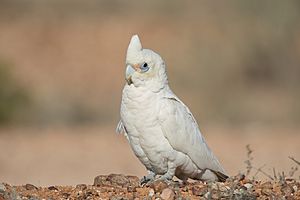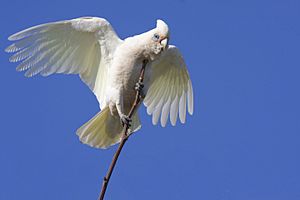Little corella facts for kids
Quick facts for kids Little corella |
|
|---|---|
 |
|
| In Coober Pedy, Australia | |
| Conservation status | |
| Scientific classification | |
| Subspecies | |
|
C. s. sanguinea |
The little corella (Cacatua sanguinea), also known as the bare-eyed cockatoo, is a type of white cockatoo. These birds live in Australia and southern New Guinea. The Yindjibarndi people of the central and western Pilbara region used to call them Birdirra. They would keep them as pets or use them for food. The soft feathers of the little corella are still used in traditional ceremonies and dances today.
Contents
About the Little Corella
The first official description of the little corella was written by an English bird expert named John Gould in 1843. There are a few different types, or subspecies, of the little corella:
- C. s. sanguinea
- C. s. normantoni
- C. s. transfreta
- C. s. gymnopis
What They Look Like
The little corella is a small white cockatoo. It usually grows to be about 35 to 41 centimetres (14 to 16 inches) long. It weighs between 370 and 630 grams (13 to 22 ounces).
This bird looks a lot like the long-billed corella and the western corella. However, the little corella is smaller. Also, its upper and lower beak parts are about the same length. You can tell it apart from the long-billed corella because it doesn't have an orange patch on its throat.
Some subspecies have slight differences. For example, C. s. gymnopis has darker blue rings around its eyes. Female corellas are usually a bit smaller than males.
Where They Live
Little corellas live in many different places across Australia. You can find them from the dry deserts in the middle of Australia to the green coastal areas in the east. They do not live in thick forests.
These birds are also common in cities like Canberra, Sydney, and Brisbane. Here, they often search for food on lawns and sports fields. They are very common on farms in New South Wales and Queensland. In some areas, they have become so numerous that they can cause problems. They might damage trees by chewing off the bark from small branches.
Little Corella Behaviour
Little corellas often gather in very large groups. These groups can have thousands of birds. Sometimes, other birds like galahs and sulfur-crested cockatoos join them.
They usually sleep in trees at night. In the early morning, they fly off to find food. They return to their roosting trees in the late evening. Flocks might fly many kilometres between where they eat and where they sleep. In desert areas, they also need to fly to water sources twice a day.
Their Call
Little corellas make loud, high-pitched calls and screeches. Their calls sound a bit like the sulfur-crested cockatoo. When many birds call at the same time, it can create a very loud sound. You can often hear it from several kilometres away.
Reproduction and Life Cycle
Little corellas usually breed between May and October. In the northern parts of Australia, they tend to breed earlier in the year. They typically build their nests in hollows inside trees. They might also nest in cracks in cliffs or in termite mounds.
What They Eat
Little corellas mostly find their food on the ground. However, they sometimes eat from trees and bushes. They eat many different kinds of seeds, both wild and those grown by people. In cities, they often eat grass seeds from lawns.
They frequently eat farm crops like wheat, barley, and maize. Because of this, they can sometimes cause significant damage to farms in certain areas.
Playing Around
When little corellas play, they get very noisy. They seem to have "conversations" with each other. They fly around and also like to show off. They might hang upside-down using their feet, beaks, or both!
Challenges for Little Corellas
In 2019, about 60 corellas in Adelaide, South Australia, died in a way that seemed like poisoning. People found them falling from the sky. An animal rescue group hoped that tests could find out what happened. In Australia, people need to register if they buy certain poisons.
Local councils had previously discussed managing corella numbers. This is because these birds can sometimes damage crops and chew on things like streetlights. They can also affect buildings and sports equipment. Sometimes, they might take over areas where other native birds and animals live.
Images for kids
-
Little corella on nest. Near Tibooburra, NSW
See also
 In Spanish: Cacatúa sanguínea para niños
In Spanish: Cacatúa sanguínea para niños





